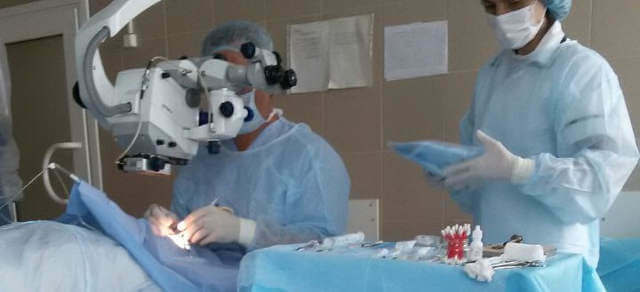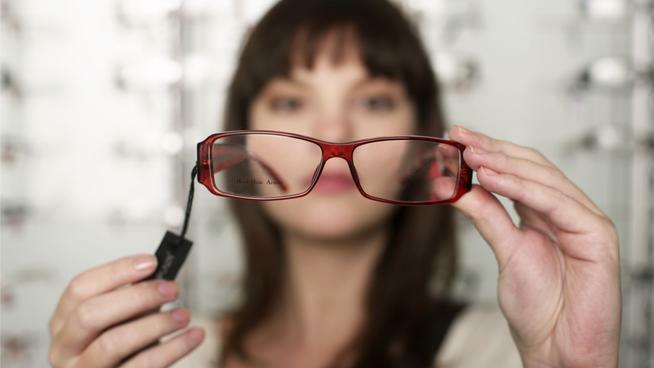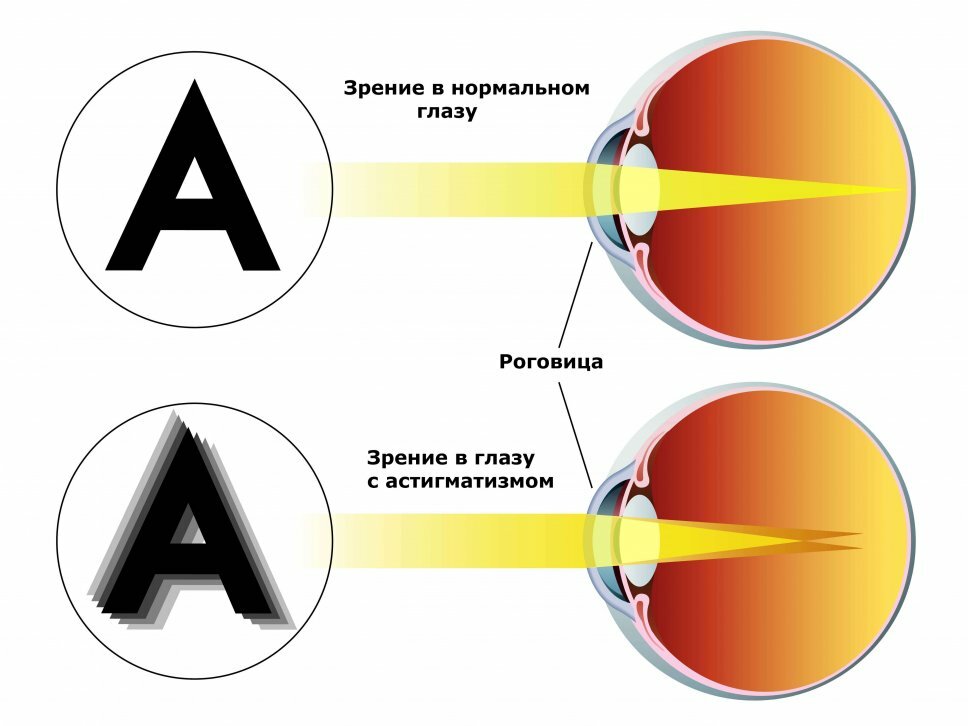Dry Eye Syndrome: Symptoms and Treatment
 Dry eye syndrome( SSS), otherwise known as corneal conjunctival xerosis, is a pathology that occurs primarily in highly developed countries.In these countries, 7-17% of the population are sick, two thirds of whom are women.The cause of it can become both household factors, and some diseases, the symptomatology is diverse, and the treatment is rather difficult.
Dry eye syndrome( SSS), otherwise known as corneal conjunctival xerosis, is a pathology that occurs primarily in highly developed countries.In these countries, 7-17% of the population are sick, two thirds of whom are women.The cause of it can become both household factors, and some diseases, the symptomatology is diverse, and the treatment is rather difficult.
Causes of Dry Eye Syndrome
CAS causes can be divided into two categories :
- are those that reduce the production of tear fluid;
- are those that reduce the stability of tear film.
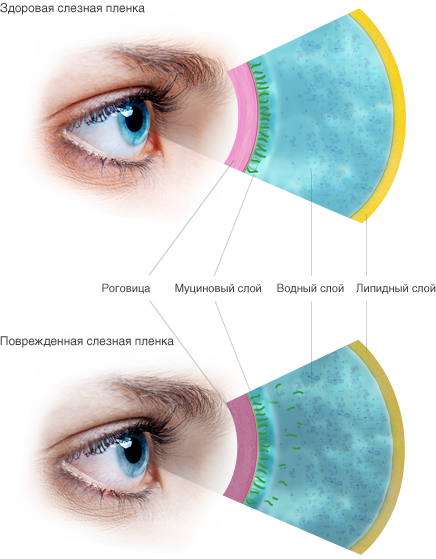
In the first category are
1. autoimmune pathology:
- Sjogren's syndrome;
- transplant rejection reaction;
- processes, which have an immune base and develop as a result of irradiation of the areas of the head and neck with ionizing radiation);
2. pathology of hematopoietic and reticuloendothelial systems:
- rheumatoid arthritis in combination with enlarged spleen and a decrease in neutrophil blood( Felty syndrome);
- lymphomas, lymphosarcoma, lymphatic leukemia;
- thrombocytopenic purpura;
- hemolytic anemia, etc.;
3. Endocrine disorders:
- menopause;
- diabetes mellitus;
- hypothyroidism;
- endocrine ophthalmopathy;
4. kidney disease( diabetes insipidus diabetes and tubular acidosis);
5. Any type of exhaustion, including severe infections:
- HIV;
- leprosy( leprosy);
- typhoid;
- cholera;
- Alimentary depletion;
- avitaminosis C;
- B12-deficiency anemia;
6. Lacrimal fluid disorders associated with skin diseases, such as:
- pemphigus;
- Lyell's syndrome;
- exfoliative dermatitis;
- ichthyosis;
- rosacea( rosacea);
- neurodermatitis;
7. Pregnancy.
The second category includes many factors affecting the composition of the tear fluid and the ability to retain it on the eyeball. Most often household factors play a role here:
- work with computer monitors and TV sets;
- use of air conditioners and fan heaters;
- incorrect selection of contact lenses or their misuse;
- low-quality cosmetics for eyelashes or eyelid edges( mascara, eyeliner, pencils);
- Smoke or dusty air.
A slightly smaller value as a cause of CAS has such pathological conditions as:
- cicatricial changes in the cornea and conjunctiva;
- Neuroparalytic keratitis;
- lagophthalmus( incomplete closure of the eyelids) or exophthalmos( forward displacement of the eyeball, so-called eye bulge);
- Allergies;
- tear flow disturbance( dacryocystitis);
- impaired function or absence of lacrimal gland.
There are a number of drugs that can cause dry eye syndrome, such as clonidine, beta blockers, indapamide, amitriptyline, etc., for long-term use.
Symptoms of dry eye syndrome
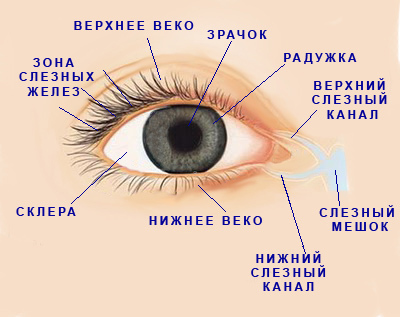
Symptoms of the "dry eye" syndrome vary widely and directly depend on the severity of damage to the membranes of the eye.
With , the mild form of , the patient complains of lacrimation, which tends to intensify when exposed to the eye by unfavorable factors.When you instill in the eyes of neutral drops a person feels pain.There is also a bad tolerance of wind, air conditioned rooms, smoke.Objectively, the doctor discovers various microarrays of xerosis.
With , the moderate course of causes a feeling of dryness of the eye, tearing is reduced and signs of insufficient production of tear fluid appear.When examined, there is a decrease in the lacrimal meniscus, swelling, and tarnishing of the conjunctiva.
With the severe form of , there are the phenomena of "filamentous" keratitis( the proliferation of corneal cells in the form of threads, erosion and ulcers of the conjunctiva, its reddening, corneal opacification, the patient notes periodic visual impairment, photophobia, burning sensation, rubbing, "foreign body"In the eye
Diagnostics
Evaluation of all data, from a thorough questionnaire and ending with instrumental methods, allows to reliably determine the patient's presence of a xerosis
In the survey, special attention is given to(Conditioned rooms, smoke, dust, etc.)
A physical examination consists of an external examination of the eye for the inadequate( incomplete) closure of the eyelids, the presence of exophthalmos, the determination of the condition of the eyelids, their skin,Eyelashes, a free edge, followed by biomicroscopy, which determines the state of the epithelium of the cornea and conjunctiva.If necessary, it is supplemented by staining with a solution of sodium fluorescein - this allows you to identify areas.Deprived of epithelium.
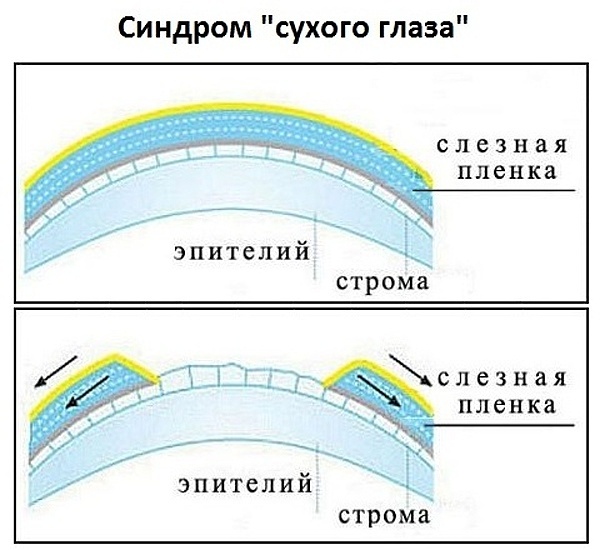
After this, a cytological examination of scrapings with the conjunctiva is performed.This is necessary for determining the state of goblet cells of this membrane.The variant of such research is impression, at which the cells do not scrape off, but are taken from special materials pressed to the eye.
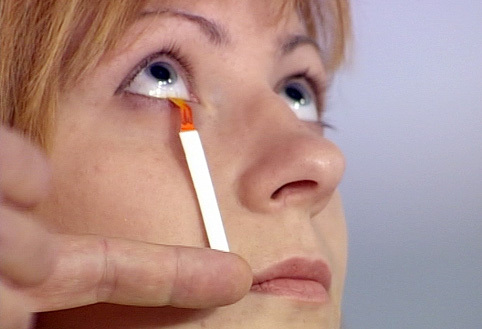
The blood and lacrimal fluid are subjected to immunological examination.Information on the state of immunity allows the appointment of a treatment appropriate to a particular case.
Crystallography of tear fluid helps to determine the nature of the processes occurring in the eye - degeneration, atrophy, acute or chronic inflammation, allergy, etc.
Only two of the instrumental studies are relevant:
- Thioscopy that helps to obtain informationChanges in the stability of tear film;
- study of tear osmolality, supplementing information on the tendency of the eyeball to dry out.
If necessary, the patient can be advised not only by ophthalmologists, but also by other specialists:
- rheumatologist;
- endocrinologist;
- gynecologist;
- dentist;
- dermatologist;
- Allergist.
Treatment of dry eye syndrome
Therapeutic measures for dry eye syndrome are aimed at achieving the following goals:
-
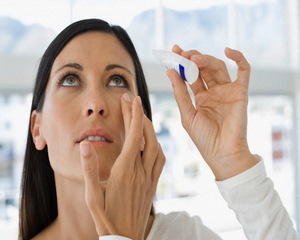 elimination of the disease that led to corneal conjunctival xerosis( correction of glucose level in diabetes, eliminationHormonal disorders, arresting of rheumatoid inflammation, etc.);
elimination of the disease that led to corneal conjunctival xerosis( correction of glucose level in diabetes, eliminationHormonal disorders, arresting of rheumatoid inflammation, etc.); - increased stability of tear film, which leads to adequate moistening of the eyeball;
- elimination of xerotic changes in the cornea and conjunctiva;
- prophylaxis of corneal complications( turbidity, ulceration).
For the most part, patients with dry eye syndrome are treated as outpatients.Hospitalized only for surgical treatment. In the conditions of a polyclinic medical methods are applied:
- Preparations of "artificial tears".These drugs are prescribed in the form of drops, which are instilled( dripped) up to 6 times a day.With a light current of xerosis, low-viscosity agents are prescribed.When severe, gel forms are effective.
- Local anti-inflammatory drugs and drugs that normalize local immunity:
- glucocorticoids are administered with a gradual decrease in concentration;
- Cyclosporine drip within a month 2-3 r / day;
- thymalin( thymogen) is administered conjunctivally;Course - 5 injections;
- levamisole is administered orally once a day;Course - 3 days.
- Metabolic agents - a gel with dexpanthenol, which contributes to the rapid development of damaged epithelium.
- Eye drops with an antiallergic active ingredient are prescribed if there are indications of the allergic nature of the xerosis.
Surgical treatment is performed in a hospital. A number of operations are carried out aimed at: Reducing the natural outflow and / or evaporation of tear fluid from the conjunctival sac;
- ;
- improvement in inflow of tears;
- elimination of complications( corneal perforation, ulcers, etc.).
To stop the outflow of tears from the cavity of the conjunctiva, various interventions aimed at closing the lacrimal point - diathermocoagulation, plastic, obturation with special cork.
Evaporation of the lacrimal fluid is performed by the operation of tarsorphia - a partial suture of the eyelids, which helps protect the cornea with endocrine ophthalmopathy.
To increase the flow of fluid to the eye, a salivary gland can be transplanted into the conjunctival cavity.Another type of operation is the drawing of a tube from special dacryores tanks, implanted next to the eye in soft tissues.
Surgical treatment of corneal ulcers is also possible.To do this, plastic surgery using conjunctiva or amnioplasty using a canned amnion( one of the shells of the fetus) is performed.
Dry eye syndrome is a very common pathology.Running it is very undesirable, because without adequate treatment it can lead to persistent loss of vision.A qualified specialist will be able to correctly diagnose this pathological condition and prescribe adequate treatment.
Bozbey Gennady Andreevich, ambulance doctor

